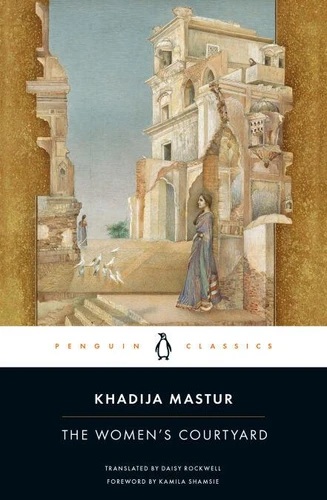The Women's Courtyard
Par : , ,Formats :
Disponible dans votre compte client Decitre ou Furet du Nord dès validation de votre commande. Le format ePub protégé est :
- Compatible avec une lecture sur My Vivlio (smartphone, tablette, ordinateur)
- Compatible avec une lecture sur liseuses Vivlio
- Pour les liseuses autres que Vivlio, vous devez utiliser le logiciel Adobe Digital Edition. Non compatible avec la lecture sur les liseuses Kindle, Remarkable et Sony
- Non compatible avec un achat hors France métropolitaine
 , qui est-ce ?
, qui est-ce ?Notre partenaire de plateforme de lecture numérique où vous retrouverez l'ensemble de vos ebooks gratuitement
Pour en savoir plus sur nos ebooks, consultez notre aide en ligne ici
- Nombre de pages320
- FormatePub
- ISBN978-0-593-51215-9
- EAN9780593512159
- Date de parution15/07/2025
- Protection num.Adobe DRM
- Taille1 Mo
- Infos supplémentairesepub
- ÉditeurPenguin Classics
Résumé
A feminist classic of Partition literature in a newly revised translation by Booker Prize-winning translator Daisy Rockwell. A Penguin ClassicSet in the turbulent decade of 1940s India, The Women's Courtyard illuminates a unique perspective on the Partition. The novel follows the struggles of a Muslim family from the perspective of the youngest daughter, Aliya, during the years that lead to Independence.
Mastur's novel is conspicuously empty of the politicking and large national questions that played out, typically, in the arenas of men. Instead, it gives expression to the preoccupations of the women, whose lives are mostly circumscribed by the secluded courtyard of their home. As they deal with the poverty that engulfs the family as a direct result of the men's all-consuming passion for the Independence Movement, the women in the courtyard are left to run the household on shrinking means, and Aliya attempts to gain an education against all odds. Set within the strict religious and social framework of a once-prominent family, The Women's Courtyard invites us into Aliya's suffocating world, where women are forced to contend with deteriorating conditions, as they try desperately to hold up the social structure that confines them.
Mastur's novel is conspicuously empty of the politicking and large national questions that played out, typically, in the arenas of men. Instead, it gives expression to the preoccupations of the women, whose lives are mostly circumscribed by the secluded courtyard of their home. As they deal with the poverty that engulfs the family as a direct result of the men's all-consuming passion for the Independence Movement, the women in the courtyard are left to run the household on shrinking means, and Aliya attempts to gain an education against all odds. Set within the strict religious and social framework of a once-prominent family, The Women's Courtyard invites us into Aliya's suffocating world, where women are forced to contend with deteriorating conditions, as they try desperately to hold up the social structure that confines them.
A feminist classic of Partition literature in a newly revised translation by Booker Prize-winning translator Daisy Rockwell. A Penguin ClassicSet in the turbulent decade of 1940s India, The Women's Courtyard illuminates a unique perspective on the Partition. The novel follows the struggles of a Muslim family from the perspective of the youngest daughter, Aliya, during the years that lead to Independence.
Mastur's novel is conspicuously empty of the politicking and large national questions that played out, typically, in the arenas of men. Instead, it gives expression to the preoccupations of the women, whose lives are mostly circumscribed by the secluded courtyard of their home. As they deal with the poverty that engulfs the family as a direct result of the men's all-consuming passion for the Independence Movement, the women in the courtyard are left to run the household on shrinking means, and Aliya attempts to gain an education against all odds. Set within the strict religious and social framework of a once-prominent family, The Women's Courtyard invites us into Aliya's suffocating world, where women are forced to contend with deteriorating conditions, as they try desperately to hold up the social structure that confines them.
Mastur's novel is conspicuously empty of the politicking and large national questions that played out, typically, in the arenas of men. Instead, it gives expression to the preoccupations of the women, whose lives are mostly circumscribed by the secluded courtyard of their home. As they deal with the poverty that engulfs the family as a direct result of the men's all-consuming passion for the Independence Movement, the women in the courtyard are left to run the household on shrinking means, and Aliya attempts to gain an education against all odds. Set within the strict religious and social framework of a once-prominent family, The Women's Courtyard invites us into Aliya's suffocating world, where women are forced to contend with deteriorating conditions, as they try desperately to hold up the social structure that confines them.



